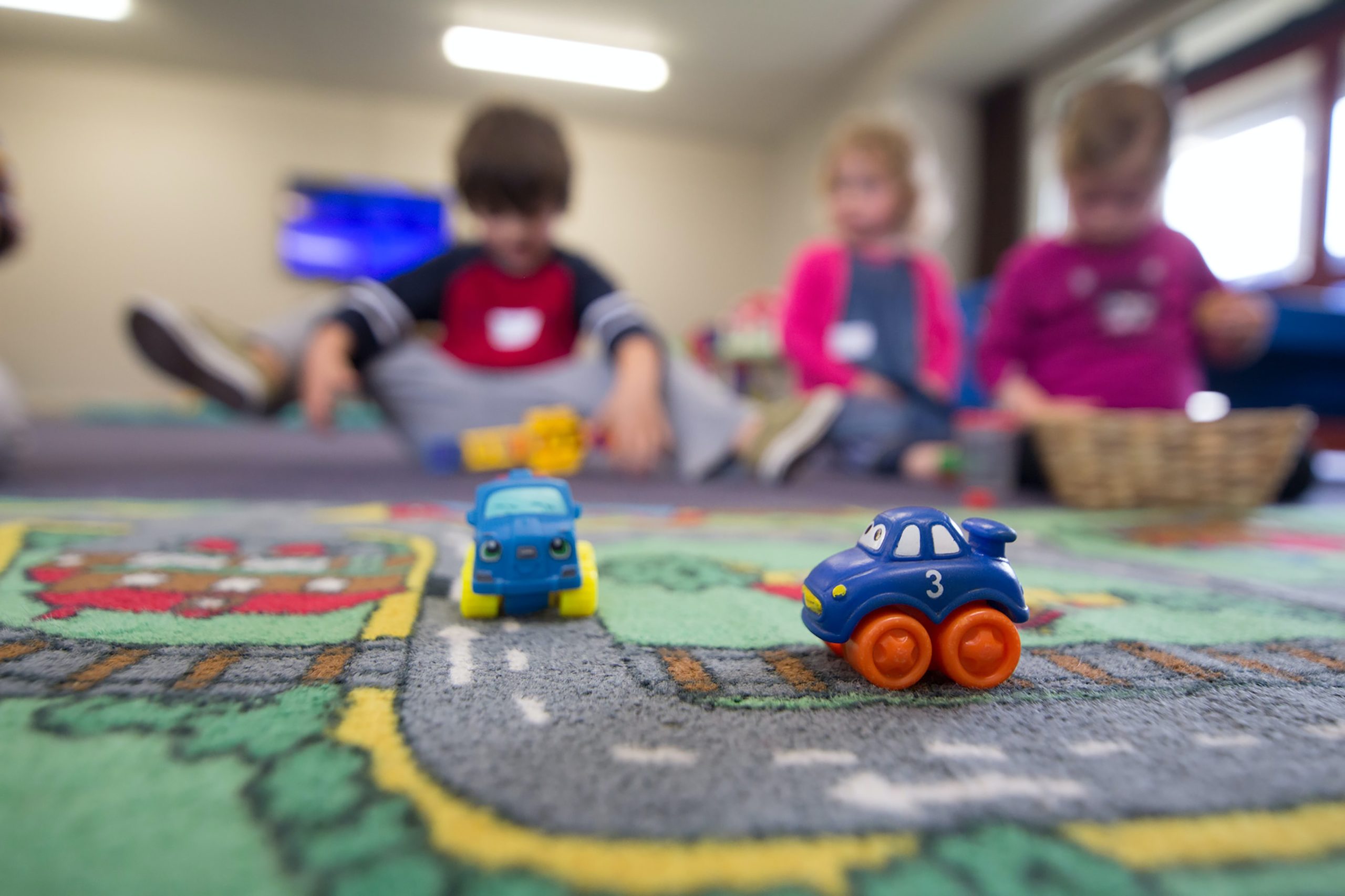By failing to invest in child care, the U.S. government is placing mothers in an impossible position.
Ashley Patrick was thrilled to land a full-time position at a prestigious publishing house in July 2016. The job came with smart, bookish colleagues, opportunities for advancement, a regular salary, and health insurance. For a Brooklyn-based writer and editor, it was a rare and valuable opportunity.
At the time she had two young sons, a husband who also worked full-time, and no flexibility. By the end of 2018, Patrick and her husband had three children. The combined monthly cost of full-time daycare for the baby and after-school programs for the boys was an unaffordable minimum of $3,250. In February 2019 she made the painful decision to leave her job.
“A big part of my decision to leave was the cost of child care,” Patrick told me in a recent phone conversation. “Which was a great disappointment because I was on an upward trajectory in the company.” She had been promoted shortly before the birth of her youngest and was on track for another promotion in the next year and a half. Getting that second promotion “would have made a big difference in terms of mobility from one publishing house to another.”
The kids are now nine, seven, and 18 months old. Patrick has managed to carve out a thriving freelance business, but, with schools and daycares closed due to the pandemic, she is now trying to work and supervise her boys’ online lessons from her small apartment. Her husband, who had been earning a good salary at a major company, was laid off eight months after she quit her own job—in part, Patrick suspects, because he took the family leave he was entitled to when their third child was born. She does not know what they’ll do when schools reopen—there is still no ideal option for the baby, and the boys attend schools in different neighborhoods with different start times, making pick-up and drop-off complicated and time-consuming.
Patrick and her family are hardly alone in finding the demands of child care and full-time employment increasingly unmanageable.
According to the Organisation for Economic Co-operation and Development (OECD), there are only four countries in the world where couples with young children who earn the average wage spend more than 30 percent of their salary on child care: New Zealand, the U.K., Australia, and the United States. In Korea, Austria, Greece, and Hungary, the average couple spends less than four percent of their income on child care. Mothers in Sweden, France, and Canada report being satisfied with the overall quality, availability, and cost of child care in those countries, all of which have government-run or heavily subsidized child care systems.
Erika Gubrium, a professor at Oslo Metropolitan University who has two sons, ages eight and 11, explained in response to questions sent by email that child care in Norway is offered through a mix of public and private day cares partially subsidized by the state. The cost of a full-time spot at a daycare in Oslo is approximately 3,100 Norwegian krone per month (around $302 USD). Some families pay reduced fees if they earn less and in some areas, day care is completely free for children of certain ages. In Gubrium’s words, “There is NO opposition to government funding of child care, as there is strong sentiment across the political board that the state should support measures that enable both parents to work full-time.”
When child care is consistent, affordable, and easy to access, more women work outside of the home. Quebec’s government-subsidized child care program led to a workforce participation rate of 85 percent for women ages 26 to 44—the highest in the world, according to University of Quebec at Montreal economist Pierre Fortin. The increased tax revenue covers more than 100 percent of what the government spends on child care. “In other words, it costs zero, or the cost is negative,” Fortin told CityLab in 2018. The program also saves money by reducing the number of families on public assistance.
Hannah Selinger, a freelance writer in East Hampton, New York, has two sons, ages three and one-and-a-half. Finding convenient child care for both, she said in a phone interview, has been a “nightmare.” She quit her well-paid job to be a stay-at-home mother when she became pregnant with her first child because her partner’s salary was double what she made. Since then her freelance writing career has taken off, requiring more of her time, but the logistics of child care are making that nearly impossible. The fee for her eldest son’s preschool is $12,000 per year for three half days per week, and it’s a 30-minute drive from her home, meaning she spends six hours per week driving him (and his little brother) there and back.
Carolina Gonzalez-Villar lives in California’s Bay Area with her husband and their four-year-old son. Her father, who is retired, took care of her son until he was 18 months old. Without her father, she said, her family would have had to bear the expense of a nanny. She and her husband decided they couldn’t afford another child, given that child care where they live costs up to $2,500 per month.
A shorter workweek would reduce both child care costs and parental stress. “We have doubled productivity since the 1960s; there is no reason we shouldn’t make the same money or better and work fewer hours,” said Erin Mahoney, who lives in Queens with her 2-year-old child. Mahoney described the search for child care as one of the most stressful parts of her pregnancy. “A month before my maternity leave ended, I was still trying to figure it out.”
The burden of navigating America’s patchwork child care system falls disproportionately on mothers. Ashley Patrick recently wrote on Facebook, in response to a comment about child care centers refusing to disclose their fees until parents have scheduled a tour, “The last thing I wanted to be doing while uncomfortably pregnant and frantically prepping at work for maternity leave and scheduling and attending a zillion doctor’s appointments was making still more phone calls and sending more emails to check tuition fees.”
Liz Grefath, a mother of two young sons who lives in Brooklyn, recently wrote on Facebook that “people use words like ‘challenge’ to describe [the search for adequate child care] but that is such a neutral word.” What most U.S. parents are really engaged in, she added, is “all-out scavenging, plotting, and survivalism.”Another problem with the U.S. system is that child care providers and preschool teachers are among the worst-paid workers in America. As of 2018, 58 percent of child care workers in California were paid so little that they qualified for public assistance. Some cannot afford to have children of their own.
“One thing I find really frustrating about child care is that it’s almost prohibitively expensive for parents yet the teachers are paid close to minimum wage,” Arielle Harrison recently wrote on Facebook. Harrison, who lives in Connecticut with her husband and their two young sons, continued: “I don’t see how the economics work without some form of government subsidy.”
The U.S. provides limited subsidies to low-income families, she acknowledged, but providers are still grossly underpaid.
Historically, the U.S. government has found the money for child care when it needed women to work. President Franklin Roosevelt used funds from a wartime infrastructure bill to establish a national network of child care centers for women who took factory jobs to support the war effort (remember Rosie the Riveter?). The centers were shut down under the Truman administration, despite a battle waged by mothers, social welfare groups, unions, early childhood educators and social workers to keep them open. That was the last time the United States offered universal child care.
In May 1971, two New York congresswomen—Shirley Chisholm of Brooklyn and Bella Abzug of Manhattan—introduced a bill that would have set aside billions of dollars in federal funds for child care. A watered-down version eventually passed the House and the Senate, only to be vetoed by Nixon, on the advice of his special assistant Pat Buchanan. Nixon described the bill as “radical,” “family-weakening” and tantamount to endorsing “communal” childrearing as opposed to “the family-centered approach.”
Jen Sunderland, a child care provider and mother of a 14-year-old in New York City, pointed out in a phone conversation that the U.S.’s “family-centered approach” is the problem. Instead of acknowledging that the entire society benefits when children are well cared for, our system places “all of the burden of that work on individual families.”
For women, child care decisions are inextricably tied to stagnant wages and unequal pay. The majority of mothers who “choose” the work of childrearing over a paying job do so because they would earn less or only marginally more than they would have to spend on child care if they worked.
The situation is even more dire for single parents. Nearly a quarter of U.S. children live in single-parent households, the vast majority of which are headed by women. Single parents earning an average wage spend 52.7 percent of their income on child care, which surely contributes to the fact that 30 percent of single mothers live below the poverty line.
Child care was a campaign issue in the 2020 presidential election cycle for the first time since the 1970s. Elizabeth Warren was the first to unveil a plan; Bernie Sanders’ plan was the most comprehensive. Joe Biden has not presented one. Earlier in 2020, he told Fortune that, under a Biden administration, children will be able to attend “high-quality, universal prekindergarten at no cost” and parents “will get up to $8,000 in tax credits” to offset child care costs. In 2016 the Center for American Progress, which advised Hillary Clinton’s presidential campaign, recommended offering child care tax credits of up to $14,000 per child.
The pandemic has brought the U.S.’s deepening child care crisis into even sharper relief. Daycares are closed and many schools will not reopen until the fall. Millions of parents are now either seeking work or attempting to hold onto their jobs while caring full-time for young children. In states where businesses are reopening, many now face a choice between returning to work and leaving their kids who knows where, or staying at home with their kids and losing their jobs or part of their income.
In a 1981 op-ed headlined “Congress is Subsidizing Deterioration of Family,” Joe Biden argued against expanding a child care tax credit to include families with higher incomes and labeled day care centers and nursing homes “monuments to our growing unwillingness to accept personal responsibility for those to whom we owe the most.”A lot has changed since 1981. What hasn’t changed is the need for the government to treat child care as a social responsibility, not a personal one.
Whatever happens in November, the U.S. will almost certainly end up with either a President Trump, who has agreed to spend more on child care block grants for low-income families and doubled the federal child tax credit to $2,000, or a President Biden, who has talked about “making sure that every single solitary person needing child care gets an $8,000 tax credit.” The average American family spends nearly $15,000 a year on child care.“We dread the idea that our day care might not come back from [the pandemic],” Josef Szende, who grew up in Canada and lives in New York City with his wife and their 15-month-old son, told me via Zoom. “We don’t know what we would do…we’d move from that lucky whatever percent who somehow made it work in New York City into the majority for whom it’s not working.”
Congress voted to invest billions in child care nearly 50 years ago. It’s past time to make good on that promise.



